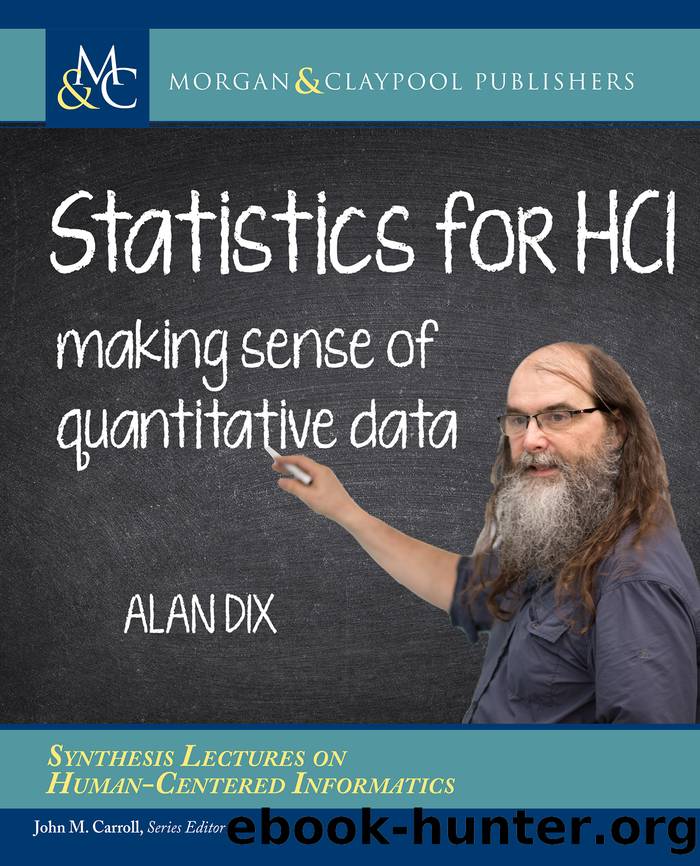Statistics for HCI by Alan Dix

Author:Alan Dix [Dix, Alan]
Language: eng
Format: epub
Publisher: Morgan & Claypool Publishers
Published: 2020-02-14T22:00:00+00:00
7.4 HOW DO YOU GET THE PRIOR?
Sometimes you have strong knowledge of the prior probability, perhaps based on previous similar experiments. While this is commonly the case when Bayesian inference is used in internal algorithms, it is unlikely to be the case in more typical usability settings such as the comparison between two systems. In the latter you are usually attempting to quantify your expert judgement.
Sometimes the evidence from the experiment or study is so overwhelming that it doesnât make much difference what prior you choose ⦠but in such cases hypothesis testing would give very high significance levels (small p-values), and confidence intervals very narrow ranges. It is nice when this happens, but if this were always the case we would not need the statistics!
Another option is to be conservative in your prior. The first example we gave was very conservative, giving the new system a low probability of success. More commonly, a uniform prior is used, giving everything the same prior probability. This is easy when there are a small number of distinct possibilities, you just make them equal, but itâs a little more complex for unbounded value ranges, where often a Cauchy distribution is used ⦠this is bell shaped, a bit like the Normal distribution, but has fatter edges, like a fried egg with more white.
In fact, if you use a uniform prior then the results of Bayesian statistics are pretty much identical to traditional statistics, the posterior is effectively the likelihood function, and the odds ratio is closely related to the significance level. Indeed in a re-analysis of the data from 855 psychology articles, Wetzels et al. found very little difference in using traditional or Bayesian methods [75].2
As we saw, if you do not use a uniform prior, or a prior based on well-founded previous research, you have to be very careful to avoid confirmation bias.
Download
This site does not store any files on its server. We only index and link to content provided by other sites. Please contact the content providers to delete copyright contents if any and email us, we'll remove relevant links or contents immediately.
Exploring Deepfakes by Bryan Lyon and Matt Tora(8345)
Robo-Advisor with Python by Aki Ranin(8291)
Offensive Shellcode from Scratch by Rishalin Pillay(6414)
Microsoft 365 and SharePoint Online Cookbook by Gaurav Mahajan Sudeep Ghatak Nate Chamberlain Scott Brewster(5667)
Ego Is the Enemy by Ryan Holiday(5343)
Management Strategies for the Cloud Revolution: How Cloud Computing Is Transforming Business and Why You Can't Afford to Be Left Behind by Charles Babcock(4546)
Python for ArcGIS Pro by Silas Toms Bill Parker(4494)
Machine Learning at Scale with H2O by Gregory Keys | David Whiting(4257)
Elevating React Web Development with Gatsby by Samuel Larsen-Disney(4212)
Liar's Poker by Michael Lewis(3411)
Learning C# by Developing Games with Unity 2021 by Harrison Ferrone(3341)
Speed Up Your Python with Rust by Maxwell Flitton(3295)
OPNsense Beginner to Professional by Julio Cesar Bueno de Camargo(3261)
Extreme DAX by Michiel Rozema & Henk Vlootman(3247)
Agile Security Operations by Hinne Hettema(3169)
Linux Command Line and Shell Scripting Techniques by Vedran Dakic and Jasmin Redzepagic(3159)
Essential Cryptography for JavaScript Developers by Alessandro Segala(3130)
Cryptography Algorithms by Massimo Bertaccini(3071)
AI-Powered Commerce by Andy Pandharikar & Frederik Bussler(3035)
